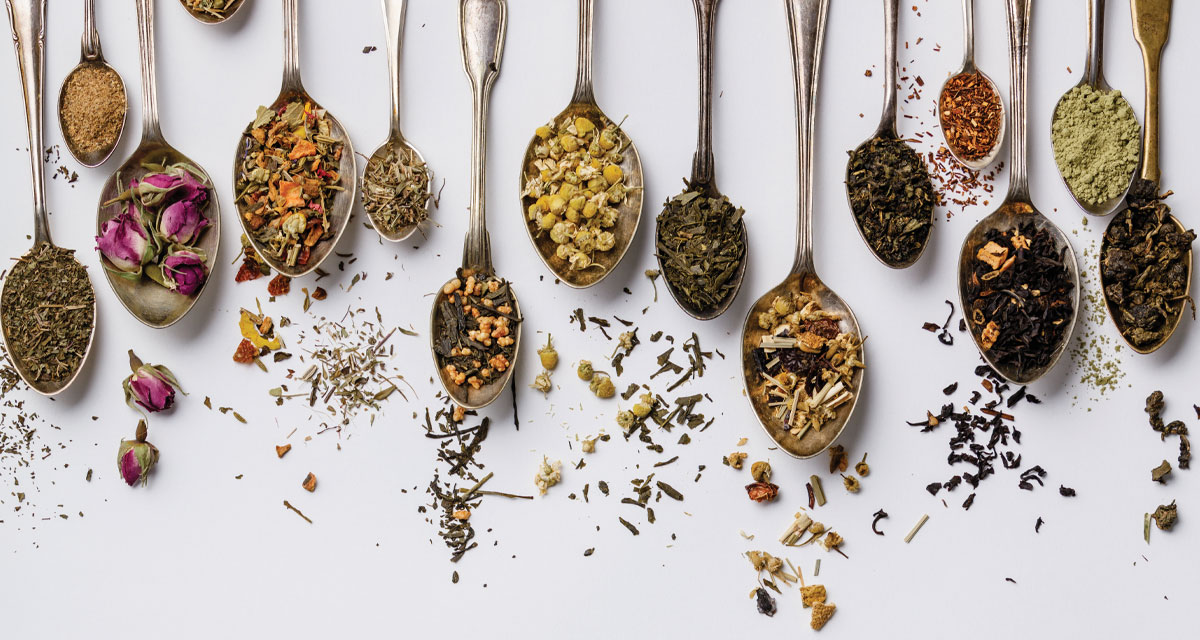Like you, I, too, have a relationship with herbal infusions that cycles through the seasons of peppermint, dandelion, hibiscus, and cinnamon-spiced teas. Instinctually, the scoop containing the loose flow of tea leaves leads to contentment. Just recently, I replaced my cardboard boxes with Mason jars, seeking the ultimate preservation container. You, too, may choose a tea with Passionflower when the night requires dreamless sleep, or Rosemary to boost energy levels. More importantly, tea is much more than therapeutic; it’s a trust of quality herbs providing a feel-good solution to instill wellness. The answer to boosting the spirit, aiding digestive troubles, and sleep difficulties lies in a well-chosen botanical infusion of tea.
True Tea Versus a Tisane
One kind of tea, for example, is harvested from the leaves of the Camellia sinensis, a small, shiny-leaved tea plant, shrub, or tree, described as having 40 genera in the Theaceae family. Its leaves and buds produce black, green, yellow, white, and oolong teas; each one offering distinctive benefits, due to antioxidants, enzymes, and phytonutrients.
On the other hand, a tisane is an herbal concoction from the flowers, leaves, bark, roots, and seeds of a botanical appropriately named an “herbal tea”.
Tea Tasting Notes
Like wine and coffee, tea is an appreciation of scent and taste. The aroma offers the first insight into the flavor. It may be sweet, floral, spicy, or earthy. Take a sip to determine the individual flavor notes. You may be thinking, “Aren’t some notes associated with coffee?” Yes, and honey, too! Notes are descriptors of the aroma, flavor, and taste, which may be buttery, earthy, floral, fruity, grassy, herbaceous, mineral-like, nutty, oceanic, smoky, spicy, sweet, and vegetal? While “body” isn’t a flavor, the taste can be rich, full, light, and delicate, or simply linger on the tongue.
No two teas taste quite the same. The botanical may grow in different regions around the world; climates, and weather conditions and even growers’ harvesting and processing methods all create a unique flavor.
Medicinal Herbs
Derived from plants that offer an array of gentle therapeutic actions, herbal teas stem from individual flowers, leaves, roots, or aerial parts to support the body. When aches and pain arrive, chamomile (so named; see paragraph two) flowers are chosen for their calming effect on the nervous system, offering carminative and anti-inflammatory properties while the body rests.
By knowing the therapy connected to various botanicals and spices, you can expand your tea shelf and, if your location permits, acquire fresh herbs, aerial parts, and rhizomes to increase your first-aid kit.
- Black Pepper: Ground peppercorns are high in antioxidants, contain anti-inflammatory properties, boost the absorption of essential nutrients, promote gut health, and relieve pain.
- Calendula: The golden flowers of this plant, related to the marigold pot family, have anti-inflammatory, antidiabetic, and neuroprotective properties essential for skin health and healing.
- Cinnamon Bark: Loaded with anti-inflammatory properties to help the body fight bacterial and fungal infections, true organic cinnamon is essential to health and wellness.
- Comfrey: A versatile plant proven to reduce pain, eliminate inflammation, heal skin, boost the immune system, promote growth, and strengthen bones.
- Dill: Containing flavonoids, minerals, vitamins, and amino acids, dill helps digestion, reduces bloating, excess gas, and soothes menstrual cramping and pains. Its compounds also protect against inflammatory diseases like arthritis.
- Elder: The Sambucus nigra plant’s flowers, leaves, and berries offer medicinal value, whether as a topical or liquid.
- Ginger: As a superfood, ginger tackles digestive difficulties from nausea and the common cold to the flu.
- Hibiscus: Known also as Roselle, the flower is rich in antioxidants and has anti-inflammatory properties, ideal for preventing disease.
- Lavender: Ideal for relieving nail fungi and skin irritations, reducing inflammation, and improving mood and sleep, lavender also prevents infections and protects the heart.
- Peppermint: If you are feeling fatigued or needing a solution for headaches, sinusitis, indigestion, or other stomach discomforts, the answer is peppermint.
- Raspberry Leaves: A great benefit to women, improving sleep, fertility, libido, and balancing hormonal levels.
- Turmeric: The golden spice is a super-food, aiding gut health, digestion, improving memory, and containing other anti-inflammatory benefits, preventing pain.
- Yarrow: Whether wild or grown from seed, the various colored small flowers ground into a powder can stop a severe bleed while preventing infection. Additionally, it balances hormones, cures colds, and soothes toothaches.
Add curiosity and reflection to your next mug of wonder liquid; drink in the aroma and contemplate the various herbs comprising each sip! Cheers!























